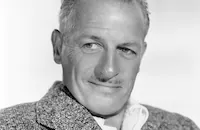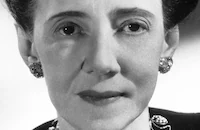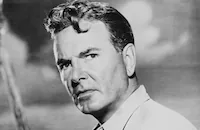Bulldog Drummond's Bride

Brief Synopsis
Cast & Crew
James Hogan
John Howard
Heather Angel
H. B. Warner
Reginald Denny
E. E. Clive
Film Details
Technical Specs

Synopsis
Cunning bank robber Henri Armides blows up the vault of the Southern Midland Bank in broad daylight and escapes with £10,000. Fleeing from the police, Armides disguises himself as a mad house painter and slips into Hugh Drummond's new flat, where he conceals the money in a radio and then cleverly slips through the police line inside an ambulance. Hugh suspects a connection between the painter and the bank robber, and his suspicion is substantiated later that night when he and his friend Algy Longworth return to the flat and surprise Armides, who has come to retrieve his money. In the ensuing fight, Armides escapes, but the loot slips out of his control when Hugh ships the radio to a small town in France where Phyllis Clavering, Hugh's fiancée, is once again waiting at the altar. Armides traces the radio to France and is followed there by Hugh. However, when Hugh arrives in the small town, he is arrested as a spy in a case of mistaken identity, and put in jail. There, he meets Armides' accomplice, Garvey, who divulges everything about the London bank robbery. Meanwhile, Colonel Nielson of Scotland Yard arrives and convinces the police to keep Hugh in jail until the wedding can take place. As Hugh and Phyllis prepare to recite their vows, Armides breaks into the jail and steals the radio. Hugh dashes from his bride's side to pursue the bank robber in a daring chase across the town's rooftops. After finally recovering the money, Hugh at last succeeds in marrying the ever patient Phyllis.

Director
James Hogan
Cast

John Howard

Heather Angel

H. B. Warner

Reginald Denny

E. E. Clive

Elizabeth Patterson

Eduardo Ciannelli
Gerald Hamer

John Sutton
Neil Fitzgerald
Louis Mercier
Adia Kuznetzoff
Adrienne D'ambricourt
Jacques Lory
George Davis
James Kelso
Matthew Boulton
Paul Cremonesi
Wyndham Standing
Gerald Rogers
Herbert Holcombe
Dick Rush
Jack Perrin
James Kilgannon
Clyde Cook
John Power
David Torrence
Fritzi Brunette
Crew
Roland Asher
Franz Bachelin
Hans Dreier
Harry Fischbeck
A. E. Freudeman
Charles Hisserich
Chandler House
William Lebaron
Stuart Palmer
Glenn Rominger
Stuart Walker
Garnett Weston

Film Details
Technical Specs

Articles
Bulldog Drummond's Bride
As the final film in the series opens, Drummond (John Howard) and his infinitely patient fiancée, Phyllis (Heather Angel), are once again planning their wedding, this time in the French countryside. To muck things up, criminal mastermind Henri Armides (Eduardo Cianelli) robs a bank and hides the loot in Drummond's radio set before escaping the cops by impersonating a madman. When he comes back for his money, he runs head on into the adventurer, who lets slip that he had sent to the radio to Phyllis in France. Before long Cianelli, Howard, best friend Algy (Reginald Denny) and butler Tenny (E.E. Clive) are all racing to intercept the radio with Drummond's Scotland Yard contact, Col. Neilson (H.B. Warner), hot on their trail. Can the good guys recover the loot in time to get Phyllis to the altar at last? Perhaps the film's shooting title, Mr. and Mrs. Bulldog Drummond, supplies a clue to that mystery.
By the eighth film in their Bulldog Drummond series, Paramount was going more for comedy than thrills. Though there's a pretty good rooftop chase and fight at the climax, there's also a great deal of time devoted to comedy, most of it supplied by bumbling best friend Denny and Cianelli's apprentice in crime, Garvey (Gerald Hamer).
According to the credits, the film is based on "Bulldog Drummond and the Oriental Mind," one of the last Bulldog Drummond stories written by the character's creator, H.C. McNeile, who signed his Drummond pieces "Sapper." The piece was published posthumously in the Strand's October 1937 issue. This film may have the most tenuous connection to its original story of any other in the series. McNeile dealt with Drummond's attempt to help a client's uncle deal with a mysterious cousin who suddenly turned up at his home with a sinister Asian servant, but not a single character or plot turn ends up in the movie.
With Bulldog Drummond's Bride, Paramount would lay the series to rest, though adaptations of work by McNeile and his successor in writing about Bulldog Drummond, Gerald Fairlie, would continue just a year later with Bulldog Sees It Through (1940), a British film starring Jack Buchanan. There would not be another film series until 1947, when Columbia released two films starring Ron Randell as Drummond. Howard would have one more major role, as Katharine Hepburn's stuffy fiancé in The Philadelphia Story (1940), before service in World War II kept him off the screen for five years. He never regained any career momentum after that. Angel got to play one of the Bennet sister's in MGM's adaptation of Pride and Prejudice (1941) and the pregnant Mrs. Higgins in Alfred Hitchcock's Lifeboat (1944), but she, too, found her days as a leading lady were soon over. The other regulars in Paramount's Bulldog Drummond series were character actors, a much more long-lived breed than leading players. Denny, who had been involved in aviation since 1930, developed a more efficient target dummy for aerial combat training during World War II. He also continued playing strong supporting roles, most notably as Cary Grant's architect in Mr. Blandings Builds His Dream House (1948). Warner continued working steadily, though advancing age would finally cut back on his screen appearances. He played himself as one of the "waxworks" playing bridge with Gloria Swanson's Norma Desmond in Sunset Boulevard (1950) and finished his career with a small role in old friend Cecil B. DeMille's The Ten Commandments (1956). For Clive, however, the end was near. After finishing the Bulldog Drummond series, he continued acting steadily as one of the screen's chief embodiments of English virtue in films like The Adventures of Sherlock Holmes (1939) and Pride and Prejudice, but then died of a sudden heart attack in 1940 at the age of just 59.
Director: James P. Hogan
Producer: Stuart Walker
Screenplay: Stuart Palmer, Garnett Weston
Based on the novel "Bulldog Drummond and the Oriental Mind" by H.C. 'Sapper' McNeile) Cinematography: Harry Fischbeck
Score: John Leipold
Cast: John Howard (Capt. Hugh C. 'Bulldog' Drummond), Heather Angel (Phyllis Clavering), H.B. Warner (Colonel Nielson), Reginald Denny ('Algy' Longworth), E.E. Clive ('Tenny' Tennison), Elizabeth Patterson (Aunt Blanche), Eduardo Ciannelli (Henri Armides), Gerald Hamer (Garvey)
By Frank Miller

Bulldog Drummond's Bride
Quotes
Trivia
Notes
The working title of this film was Mr. and Mrs. Bulldog Drummond. A news item in Hollywood Reporter notes that Paramount used Agfa's new infrared film stock for photographing this picture. The new stock allowed the filming of night sequences during daylight. For additional information about the character of Bulldog Drummond entries for Bulldog Drummond Strikes Back and Bulldog Drummond Escapes and consult the Series Index.














